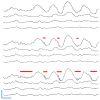The effect of increased intracranial EEG sampling rates in clinical practice
- PMID: 29288992
- PMCID: PMC5955774
- DOI: 10.1016/j.clinph.2017.10.039
The effect of increased intracranial EEG sampling rates in clinical practice
Abstract
Objective: Recent research suggests that high frequency intracranial EEG (iEEG) may improve localization of epileptic networks. This study aims to determine whether recording macroelectrode iEEG with higher sampling rates improves seizure localization in clinical practice.
Methods: 14 iEEG seizures from 10 patients recorded with >2000 Hz sampling rate were downsampled to four sampling rates: 100, 200, 500, 1000 Hz. In the 56 seizures, seizure onset time and location was marked by 5 independent, blinded EEG experts.
Results: When reading iEEG under clinical conditions, there was no consistent difference in time or localization of seizure onset or number of electrodes involved in the seizure onset zone with sampling rates varying from 100 to 1000 Hz. Stratification of patients by outcome did not improve with higher sampling rate.
Conclusion: When utilizing standard clinical protocols, there was no benefit to acquiring iEEGs with sampling rate >100 Hz. Significant variability was noted in EEG marking both within and between individual expert EEG readers.
Significance: Although commercial equipment is capable of sampling much faster than 100 Hz, tools allowing visualization of subtle high frequency activity such as HFOs will be required to improve patient care. Quantitative methods may decrease reader variability, and potentially improve patient outcomes.
Keywords: High frequency; Macroelectrode; Seizure onset.
Copyright © 2017 International Federation of Clinical Neurophysiology. Published by Elsevier B.V. All rights reserved.
Conflict of interest statement
Conflict of interest
None of the authors have potential conflicts of interest to be disclosed.
I confirm that I have read the Journal’s position on issues involved in ethical publication and affirm that this report is consistent with those guidelines.
Figures



References
Publication types
MeSH terms
Grants and funding
LinkOut - more resources
Full Text Sources
Other Literature Sources
Medical

